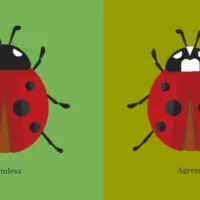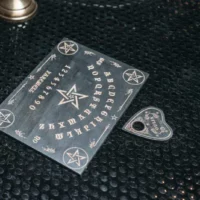Ladybugs are well known for being the good guys of the beetle world. They’re harmless, cute, little critters who occasionally land on you and bring you good luck. Unfortunately, there’s an imposter out there pretending to be the cute and innocent ladybug – but isn’t. They’re called Asian lady beetles and were first introduced to North America in California in 1916 as biological control agents to combat aphids (small bugs that feed by sucking sap from plants.) Unfortunately, these little pests are now more of a problem than the aphids originally were. An invasive species, they’ve taken over the native ladybug and our gardens. (1)
Ladybugs
Traditional red and black spotted ladybugs are the stuff of children’s cartoons. They’re often portrayed as happy, little, friendly critters that help out gardeners and farmers by eating all the bad, creepy crawlies. They’re much cuter than the other creatures who do the same job – spiders and daddy long legs. These ‘good’ ladybugs stay in the garden even when it’s cold. They seek shelter outside, happily munching on the insects invading your plants. Some gardeners and farmers even purchase these ladybugs specifically to release in their gardens and fields. They don’t bite, and they don’t congregate in large numbers. They’re the ‘good guys.’
Asian Lady Beetles
The Asian lady beetles were first introduced in 1916 but didn’t manage to stick around through their first winter. They did, however, solve the aphid problem they were being used for. Actually, they did such a fantastic job that we decided to bring them back a second and third time in 1964 and 1965. Then, a dozen more times around the North American continent from 1978 to 1982. Again, they killed off the unwanted aphids, but then failed to thrive, dying off after a season or two. It was only some time after a release in Louisiana in 1988 that they managed to begin to colonize the continent. The Asian ladybug has been growing considerably ever since. They have no natural predator in North America, as they were left behind in Asia where the beetles were imported from. Now, there are millions of the little blighters impersonating the friendly neighborhood ladybugs. (1)
Indoor Ladybugs
Unfortunately for us, Asian lady beetles like to spend their winters indoors, meaning that we end up having to share our home with them. In the winter, they swarm to attics and crevices in walls. They can often bite humans and pets alike, and they leave an annoying yellow stain. When threatened, they bleed from their knees. (Yes, you read that right!) This hemolymph, the insect equivalent of blood, is full of toxic chemicals that make them taste bad to predators and has an odor like the sour smell of rotting leaves. Imagine that all over your house! (1, 3)
How to Tell Ladybugs Apart
So, now you know about the different types of ladybugs, how do you tell them apart?

Asian Lady Beetle’s
It’s simple, really. The ‘bad’ guys have an ‘M’ shaped mark on their heads. Asian lady beetles have a distinctive, highly-visible “M-shaped” black marking on their otherwise-white heads. This marking varies in size, thickness, and overall shape, but it’s always there, no matter what. This is in contrast to the ‘good’ ladybugs who have white ‘cheek’ splodges. (4)

Regular Ladybug
How to Remove Asian Lady Beetles
Unfortunately, there’s not really any tried and true way of discouraging Asian lady beetles from entering your home. The only thing you can do is try to ensure that all cracks and openings are sealed on your property. You can either do this yourself or hire a pest control company or building contractor to make sure it’s as bug-proof as possible. Once the beetles have already found their way indoors, the easiest way to remove them is with a vacuum cleaner. (3)
Unfortunately, there doesn’t seem to be much we can do to stop the invasion of Asian lady beetles. What’s even more worrying is that over in the UK, they’ve also released them as a biological control agent. Having watched us become overrun by them – the people releasing these bugs don’t seem to have learned anything. On the bright side, what you can do is encourage more of the nice ladybugs to visit your garden by planting attractive plants for them and even set up a ladybug hotel.



